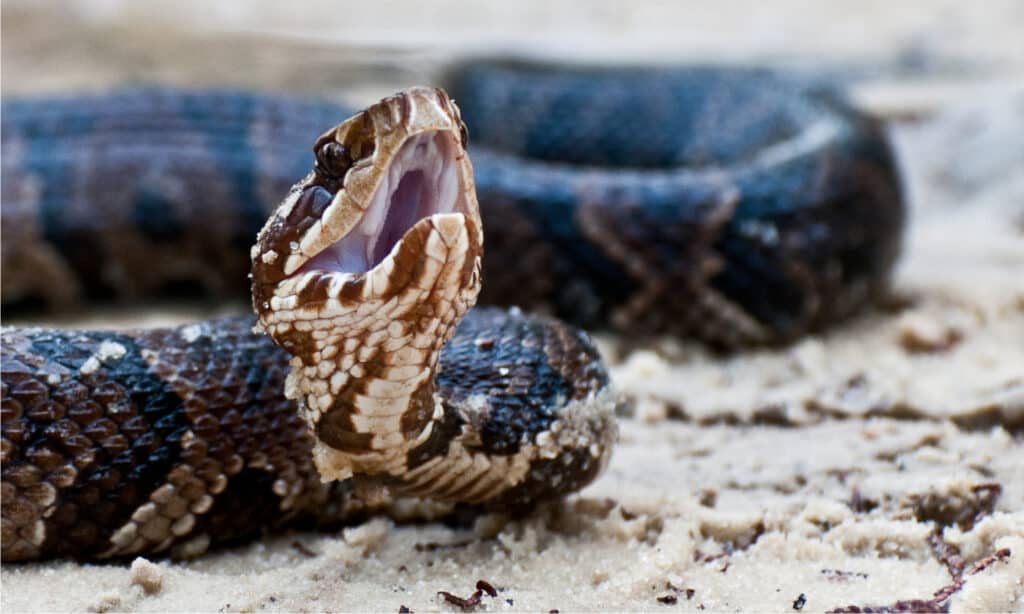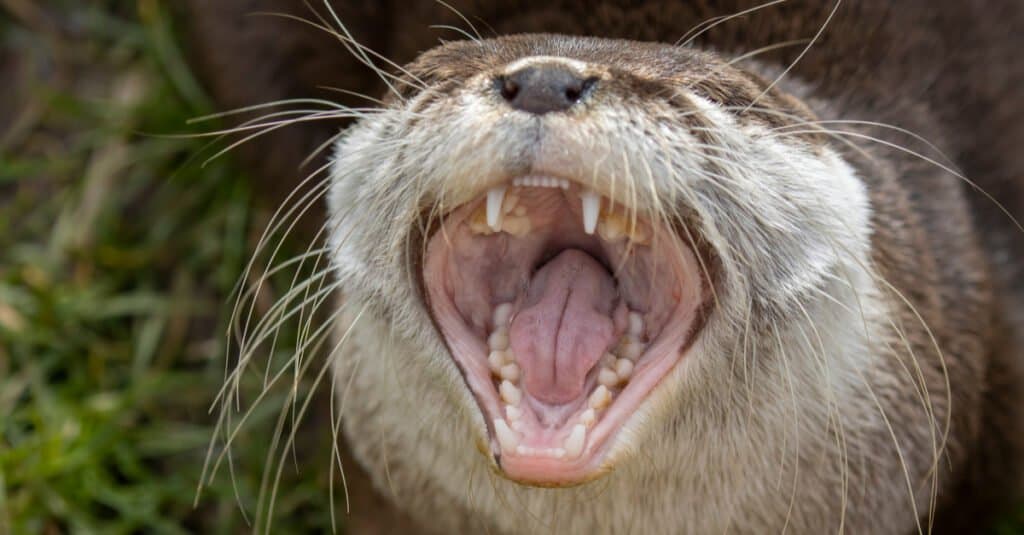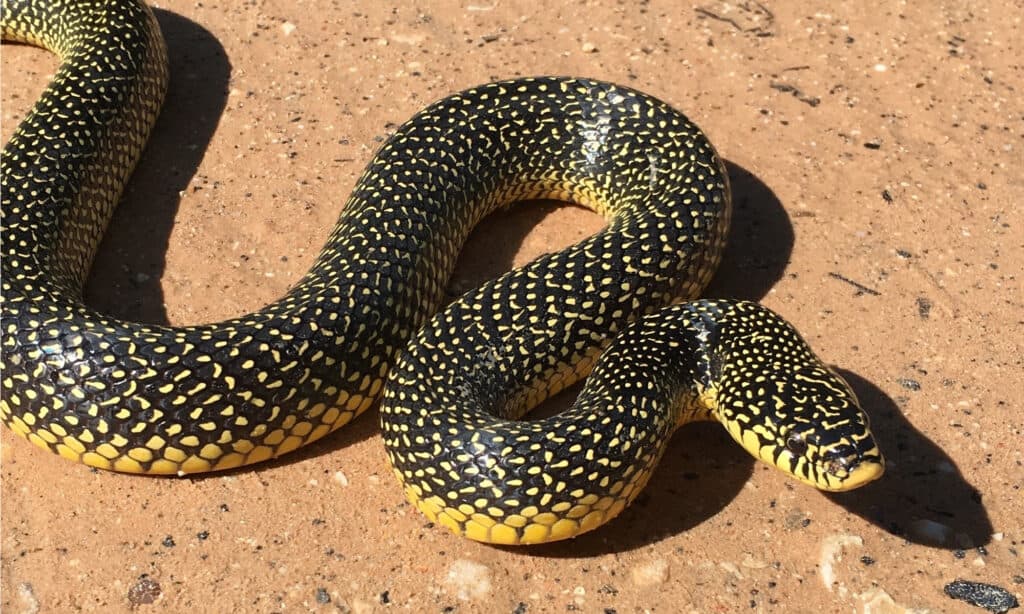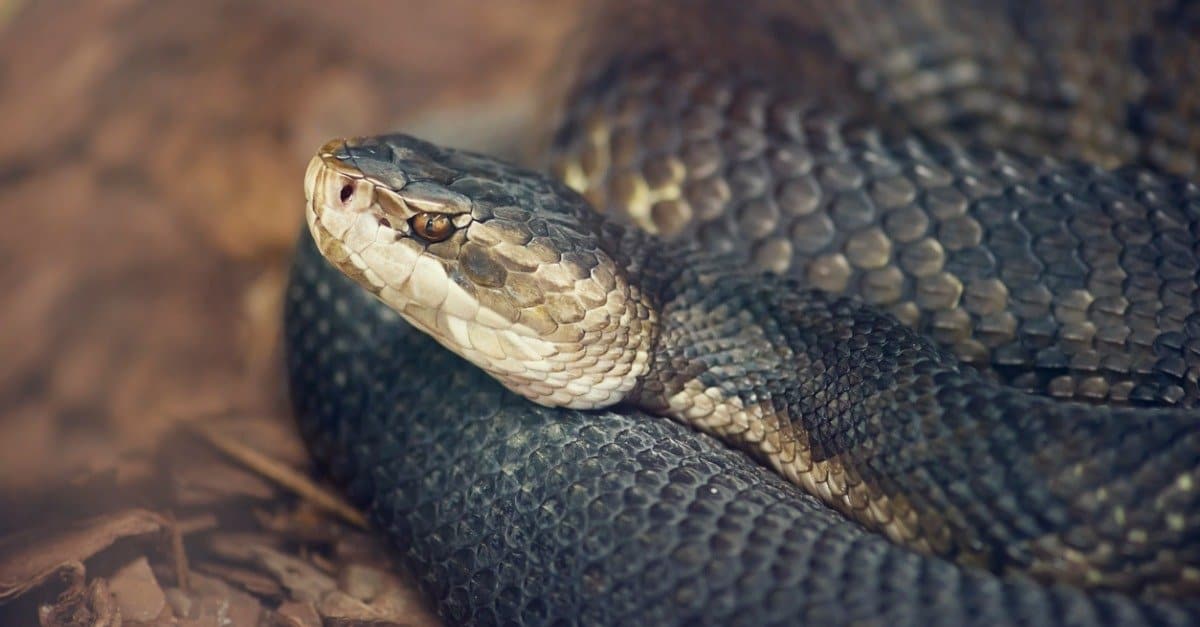Key Points:
- Cottonmouth snakes are venomous pit vipers found in the southeast of the U.S.
- Animals that hunt and kill cottonmouths include largemouth bass, snapping turtle, herons, owls, hawks, cats, otters, and raccoons.
- Kingsnakes and indigo snakes have a natural resistance to cottonmouth venom but most animals preying on cottonmouths have no form of resistance and would die from a single bite!
Cottonmouth snakes are some of the top reptiles across the southeastern United States. These venomous reptiles are some of the most dangerous snakes to be bitten by, whether you are a human or any other animal! Still, even with their deadly venom being a mere strike away, some creatures have learned how to eat these snakes as part of their regular diet. Today, we will take a look at what eats cottonmouth snakes; the answers may surprise you!
What Is a Cottonmouth Snake?

Cottonmouths are pit vipers that live in the southeastern United States.
©Jay Ondreicka/Shutterstock.com
Cottonmouth snakes are members of the pit viper family, classifying them as dangerous viper species. Aside from “cottonmouths,” these snakes go by many names, including black moccasins, gapers, mangrove rattlers, snap jaws, stub-tail snakes, swamp lions, trap jaws, water mambas, and water pilots.
They get their name from their habit of flashing their white mouths as a defense measure when they feel threatened. For most animals, that is plenty of warning and reason to get far away from these snakes. Their venom is quite dangerous, and about 12 people a year die from bites. Still, most survive and can get medical treatment.
Incredibly, some animals have made it a habit to seek out these snakes and eat them as a regular part of their diet. Let’s find out who these brave animals are!
What Eats Cottonmouth Snakes?
Although cottonmouths are dangerous, some animals have developed a natural immunity to their venom or are simply smart enough to kill them without being bitten! We’ve broken down the most common animals that are likely to kill cottonmouths to eat them. Different types of fish, turtles, birds, mammals, and other snakes hunt and eat cottonmouth snakes. Outside of killing for food, however, humans are the most dangerous predators that a cottonmouth will face.
Fish and Turtles

Largemouth bass will often eat young cottonmouths.
©Ryno Botha/Shutterstock.com
Largemouth Bass
The largemouth bass is carnivorous freshwater fish that is known for its incredible capabilities as a hunter. These fish can grow to 25 lbs, but most adult fish average around 12 lbs. Bass are extremely opportunistic feeders and will eat almost anything that they can fit in their mouths. Since cottonmouths grow to be rather large snakes, the only time a bass would be able to eat a cottonmouth is when it is young and not fully grown.
Snapping Turtle
The snapping turtle is another example of an animal that doesn’t actively seek out cottonmouths but would have no problem eating one if it wandered past. Snapping turtles share habitats with cottonmouths and won’t hesitate to eat anything that wanders past if it could swallow it. The common snapping turtle usually weighs up to 35 lbs, although the alligator snapping turtle can reach upwards of 60 lbs.
Birds

Hawks prey on various snakes, including venomous ones like the cottonmouth.
©iStock.com/Holcy
Herons
Herons and egrets are water birds that primarily prey on small fish and reptiles. They are incredible hunters and have advanced tactics to catch particular prey. When it comes to snakes, they often flash their wings to distract the snake while they kick the snake with their legs or stab their bodies. Once they’ve killed a snake, they have no problem swallowing it nearly whole!
Owls
Of all the predatory birds, owls may be the best hunters. They are silent fliers and have truly remarkable eyesight. They can spot small animals in tall grass, even from great distances using this eyesight. Owls will hunt venomous and nonvenomous snakes alike, although it usually takes a larger owl to kill adult cottonmouths.
Hawks
Like owls, hawks are large birds of prey that hunt almost anything that moves. They eat birds, mice, and small reptiles, especially snakes. Although the primary food source for hawks is small mammals, they have been documented to kill snakes for food, especially when food is scarce. Red-tailed hawks are able to kill and eat snakes that weigh up to 5 lbs without much trouble. Broad-winged hawks have a peculiar habit of skinning the entire snake before eating it!
Mammals

Otters will opportunistically eat snakes but don’t normally seek them out as prey.
©Paul A Carpenter/Shutterstock.com
Cats
With lightning reflexes and sharp wits (and claws), felines have been the historical enemies of snakes for a long time. In the southeast, housecats and bobcats are the primary felines that overlap habitat with cottonmouths. Bobcats are wild animals that regularly prey on snakes when they find one, using incredible reflexes to avoid being bitten. Housecats are also known to kill snakes for sport.
Otters
Otters primarily live in rivers and other aquatic ecosystems, meaning they share the same habitat as cottonmouths. As carnivores, they regularly eat fish but occasionally eat birds and snakes if given a chance.
Raccoons
Although raccoons don’t seem very threatening, they are quite avid hunters. These omnivores will eat almost anything, including trash, crayfish, frogs, fish, turtles, mice, rats, and even snakes. Raccoons are some of the smartest animals around and will often devise cunning methods to take down certain prey.
Snakes

Kingsnakes are venom-resistant hunters of cottonmouths, copperheads, and rattlesnakes.
©Joe Farah/Shutterstock.com
Kingsnakes
Many types of kingsnakes live across the United States, and all of them are a threat to cottonmouths. In fact, kingsnakes get their name from the fact that they have found an ecological niche of eating the snakes that other animals won’t usually touch. Kingsnakes have a natural resistance to pit viper venom and regularly kill and eat cottonmouths, rattlesnakes, and copperheads.
Indigo snakes
Indigo snakes are the largest snakes that can be found in the United States natively. They are known for their silky blue undertones and docile demeanor. Indigo snakes are similar to kingsnakes in that they have a natural resistance to pit viper venom. This allows them to prey on cottonmouths and copperheads as a part of their primary food source.
Is Everything That Eats Cottonmouth Snakes Venom-Resistant?
As we explored above, many different animals prey on cottonmouths. What’s crazy is that most of these animals don’t have any form of resistance to their venom and would die from a single bite! Still, that doesn’t stop them from killing and eating these dangerous snakes. Of the animals we looked at today, only the kingsnake and the indigo snake have a natural resistance to cottonmouth venom.
Discover the "Monster" Snake 5X Bigger than an Anaconda
Every day A-Z Animals sends out some of the most incredible facts in the world from our free newsletter. Want to discover the 10 most beautiful snakes in the world, a "snake island" where you're never more than 3 feet from danger, or a "monster" snake 5X larger than an anaconda? Then sign up right now and you'll start receiving our daily newsletter absolutely free.
Thank you for reading! Have some feedback for us? Contact the AZ Animals editorial team.








